Throughout the industrial sector, companies are constantly in search of ways to maximize profits while cutting costs and conserving space. Bulk bags have helped thousands of businesses around the world achieve this goal. From the food and pharma industries to manufacturers of gardening products and construction equipment, bulk bags provide an efficient and affordable way to package, store and transport products.
Before a line of goods leave the manufacturing plant, they are stored in containers that are safe, secure and sanitary. Whether the contents consist of granular bulk or larger equipment, the container must have the strength to bear the weight and safeguard the contents from airborne contaminants and moisture. When products are stored and transported in quality bulk bags, the contents of each bag arrive with the same clean and pure qualities as when they were packed.
The efficiency, durability and ease-of-use that companies acquire from bulk bags come from the strong material used in the construction of such bags. The process of manufacturing bulk bags also entails high levels of scrutiny when made at qualified plants. Inspection helps ensure each bag can meet international safety standards for the transportation of products, chemicals, medicines and consumable goods.
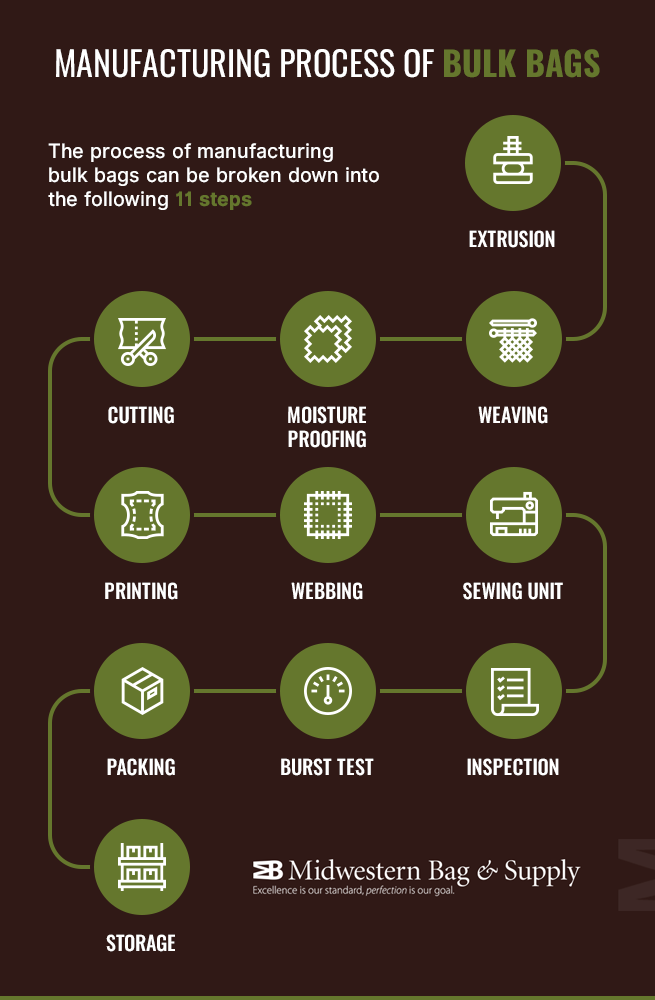
The Bulk Bag Manufacturing Process Step by Step
The bulk bag manufacturing process consists of a series of steps that apply regardless of the design or customer specifications. Whether bags need to be made square, tall, overbuilt or cost effective, each bag must undergo cyclic testing for SWL and safety factor compliance. For products that require a low moisture transfer rate, bags can be treated with laminate to improve the moisture barrier. Before bag construction begins, however, the material must be woven and cut. The process of manufacturing bulk bags can be broken down into the following 11 steps.
#1. Extrusion
The first step involves extrusion, where a mix of virgin ingredients are melted and shaped into tapes of specific measurements. The ingredients used in this process include polypropylene (PP) granules, small amount of calcium carbonate, ultraviolet inhibitors and possibly color pigmentation. At this stage, the tensile durability of the tapes is determined. The tapes are loaded onto industrial bobbins in preparation for the weaving stage.
#2. Weaving
The tapes formed from the PP granules are loaded onto weaving looms. Here, the polypropylene fabric that forms the body for a bulk bag is woven into shape. The resulting material is strong enough to carry a vast array of industrial products and consumable goods. However, it’s “breathable,” and thus subject to the passage of moisture. In addition to providing material for bulk bags, the woven PP material is also used for loading and discharge components.
#3. Moisture Proofing — Optional
Depending on the specifications of a customer, the fabric can be treated with a special laminate that renders each bag moisture-resistant. Moisture resistant is accomplished with lamination coating and is essential for bulk bags used in the transportation of granular products, as well as for any product that must never be exposed to moisture.
Regular, un-laminated polypropylene material consists of tiny strands with microscopic gaps within each weave. In essence, the material is breathable, and this can be a good quality for the transportation and storage of various materials, but ill-suited for select products. For example, sugar and salt should never be exposed to water, including water that gets sucked from the moisture in the air.
Alternately, laminated bulk bags are convenient for the transportation of light powdery products, such as flour, that could otherwise sift through the woven gaps of polypropylene material when moved or shaken. During a mass flour shipment, the loss could be substantial. With laminate-coated bulk bags, flour stays contained until it reaches its final destination.
#4. Cutting
The polypropylene fabric is fed into a slicing machine, where it’s cut into shapes of specific measurements. The measurements are determined by whether the sides, edges or bottoms are being produced during a given operation. The process by which the measurements are made is automatic, which ensures exact lengths for each cut. Whether a line of bulk bags needs to be square, tubular or vertically rectangular, the appropriate cuts are made at this stage.
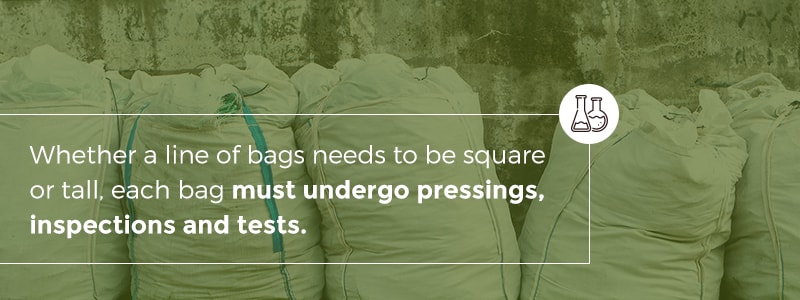
#5. Printing
Once the pieces of the polypropylene fabric have been cut into shape, they are fed into a printing machine. Here, impressions are made on the fabric. If a company has a brand name or logo that they want to be applied to a line of bags, the printing occurs at this stage. Depending on the brand in question, an assortment of colors may be implemented. For the best possible impressions, a heavy-duty printer is necessary for this process.
#6. Webbing
The handle pieces of bulk bags are made during this stage. Here, heavier tapes of polypropylene fabric are spun into webbing material. Strips of this material are then cut to precise measurements, which are determined by the size of the bags in production. These strips form the handles, or lifting loops, of each bag. On most bulk bags, the webbing strip lines the seams along each of the four sides, with handle loops above each end.
#7. Sewing Unit
At this stage, the various pieces that comprise the bulk bag — including both the square and rectangular pieces of polypropylene fabric, as well as the heavier lifting-loop strips — are put together with an industrial sewing machine. Bulk bags are sewn together in mass quantities by a team of trained hands under the watchful eye of technical supervisors. Each seam must be straight, tight and secure, with no creases or bends along any of the sides or bottom ends.
#8. Inspection
Once a line of bulk bags has been sewn together, each bag is inspected by quality control inspectors. The purpose is to ensure each bag meets the required standards of strength and durability for a product line of bulk bags. If any bags are found to be insufficiently sewn, they are removed.
#9. Burst Test
A select number of bulk bags enter into a testing ring to see whether the bags meet the Safe Working Load (SWL) test. This step helps ensure the bags in production are strong enough for their ultimate purpose. In most cases, this step is performed in advance of a general production of bulk bags. Once a production has been completed, the burst test is once again carried out on random bags to ensure the SWL is met.
#10. Packing
Now that a mass production of bulk bags has been completed, the bags are compressed and grouped into select numbers for distribution in bulk quantities. The compression is done in a bale press, the results of which allow for the neat and easy packing of the bags.
#11. Storage
With everything completed, the baled and packed bulk bags are sent to a storage room. The bags await their dispatch to various customer locations. Once received by a customer, the packed bulk bags are ready to be opened and put to use, whether the intended purpose is for the transportation or storage of building materials, rubble, food products or chemicals.
What Makes FIBC Bulk Bags Unique?
Throughout the industrial sector, Flexible Intermediate Bulk Containers (FIBC) are the preferred standard when it comes to bulk bags. With their flexibility and collapsibility, FIBCs can be used for various purposes in a multitude of settings, such as factories, pressing plants and storage facilities, as well as work sites and construction sites.
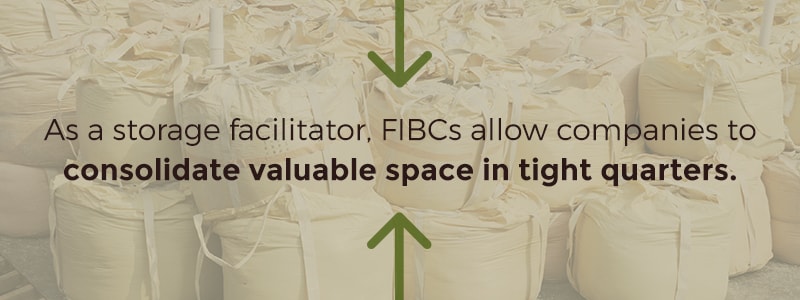
FIBCs can be used to transport materials of various measurements and parameters. As a storage facilitator, FIBCs allow companies to consolidate valuable space in tight quarters. FIBCs can also be produced in a range of sizes, and therefore, fulfill the requirements of numerous businesses and applications. Whether a company needs to store and transport items that are bulky, heavy and large, or dense, loose and granular, the task can easily be accomplished with FIBC bags.
Since FIBCs first came into use, they have provided an efficient and affordable means for the safe and sanitary transportation of food and other products with high safety requirements such as petrochemicals and substances. For bags to meet FIBC safety requirements, they must pass performance tests to ensure there is no breakage, cut, tears or safety concerns.
How Are FIBC Bulk Bags Made?
The FIBC production process is much the same as it is for regular bulk bags — polypropylene strands are woven into sheets of fabric, which are cut, treated for resistance to UV effects and sewn together by highly skilled industrial technicians. Once the production line of FIBC bags is completed, each bag is inspected and select bags are taken for burst tests to ensure Safe Working Load.
The material for FIBC bulk bags is usually made with petroleum-based, virgin polypropylene. For added moisture resistance, some FIBCs also contain inner lining made of low-density polyethylene (LDPE). The polyethylene helps to ensure that no airborne moisture seeps through the material and saturates the contents within.
Food Grade, Pharma Grade and Type C FIBC Bags
Sanitation standards are strictest in the food and medicine industries. Therefore, special preparations must be made to ensure FIBCs used in the food and pharmaceutical industries meet the highest levels of hygiene and quality. As such, bulk bags employed in these industries must be made with FDA-approved resins and manufactured in certified food safe plants.
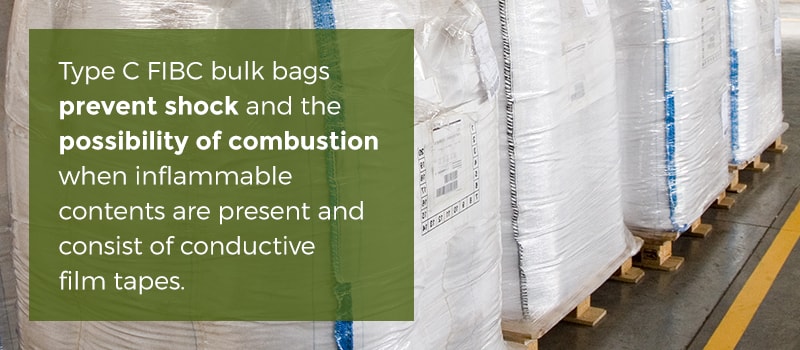
During the loading and unloading of material, electrostatic discharge can generate from conventional bulk bags. Type C FIBC bulk bags prevent shock and the possibility of combustion when inflammable contents are present and consist of conductive film tapes. Type C bags must always be properly earthed in order to dissipate static.
What Is FSSC 22000?
The Food Safety Systems Certification (FSSC) 22000 scheme is part of the Global Food Safety Initiative (GFSI). The purpose of FSSC 22000 is to safeguard the quality of foods with the employment of sanitary methods for cutting, shipping and storing a full range of consumable products, such as produce, meats, bulk foods, baking ingredients, medical supplies and various other products.
To meet FSSC 22000 requirements, materials used in the processing, packaging and storage of food must fulfill a set level of safety and sanitation standards. Bulk bags are one of many components along the food supply chain that must meet FSSC 22000 requirements.
What Is GFSI Standard for Food Grade?
The GFSI is an organization established by the international Consumer Goods Forum to implement global guidelines and safety standards for the testing of food. Under the GFSI, a business must develop management systems for food safety that meet the standards of the initiative.
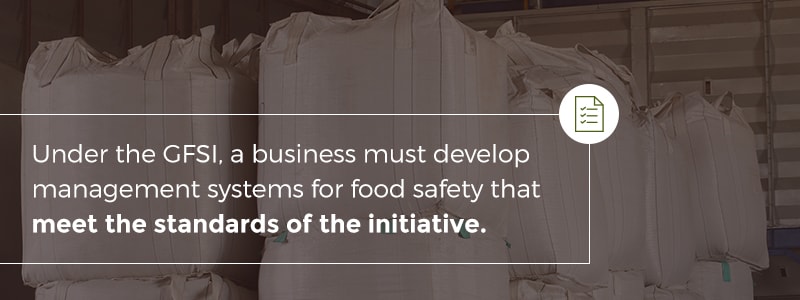
The GFSI recognizes a list of outlines designed to promote food safety, including the FSSC 22000, which encompasses everything from the cultivation of fish to the farming of fruits, vegetables, grains, cattle and fowl. Biochemical treatment and processing of produce, meats, grains and cooking products are also included in this list.
FDA Food Safety Modernization Act
In 2011, the Food Safety Modernization Act (FSMA) was signed to grant authority to the Food and Drug Administration (FDA) to oversee how foods are cultivated, processed, packaged and sold to consumers. Hailed as the most significant advancement for food safety standards in several generations, the FSMA moved the food industry’s focus on damage control to damage prevention in regards to food contamination.
Under the FSMA, the FDA can adequately contain and prevent illnesses borne from contaminated foods. The FDA has employed rigorous methods of food inspection and testing, with reviews conducted at a higher frequency on domestic, as well as international, products.
FIBC Bulk Bags From Midwestern Bag
Industries are turning to FIBC bulk bags to maximize storage space, save money on shipping costs and to deliver each product free of corruption. FIBCs take up less space than rigid containers like barrels and drums. The affordability of bulk bags makes them more cost-effective for one-way trips. FIBC bulk bags are also preferred for their superior strength — a single five-pound bulk bag is strong enough to contain 4,000 pounds of weight.
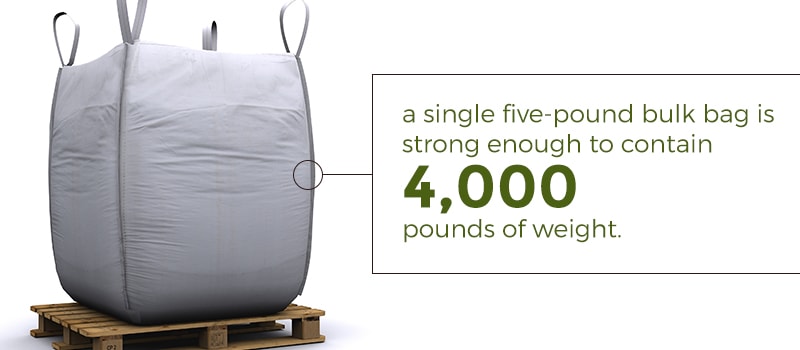
Bulk materials are packaged, stored, shipped and delivered on a daily basis to thousands of different locations. The contents of FIBC bulk bags include numerous things that people see on a daily basis, from the flour and sugar on the shelves at local supermarkets to the rocks, gravel and sand that surround buildings and gardens.
At Midwestern Bag & Supply, we design FIBC bulk bags in a range of sizes for a variety of industries. Our bulk bags are made from 100% virgin materials, making them strong and durable for the storage and transportation of most commercial and industrial bulk contents. We also do stock and custom printing on bags at the request of customers. To learn more about our bulk bags or to place an order, contact Midwestern Bag.


 Copyright © 2025 Midwestern Bag. All Rights Reserved.
Copyright © 2025 Midwestern Bag. All Rights Reserved.